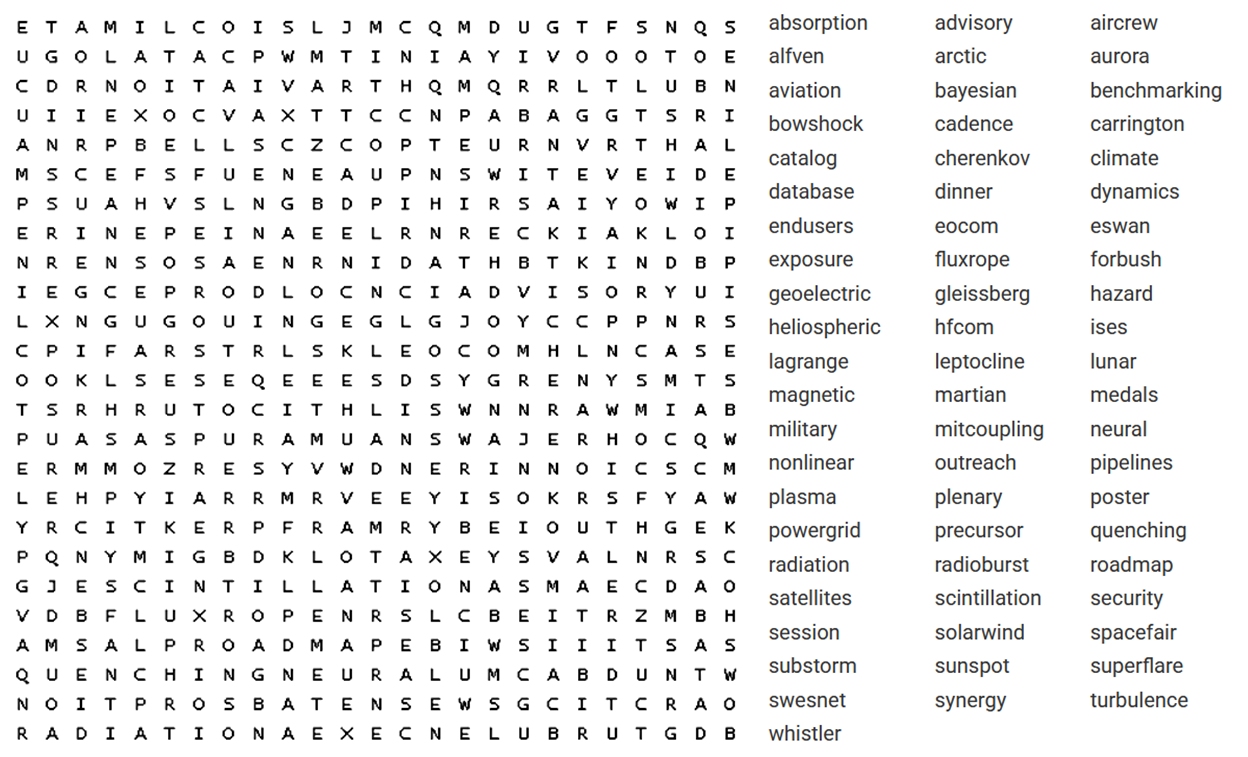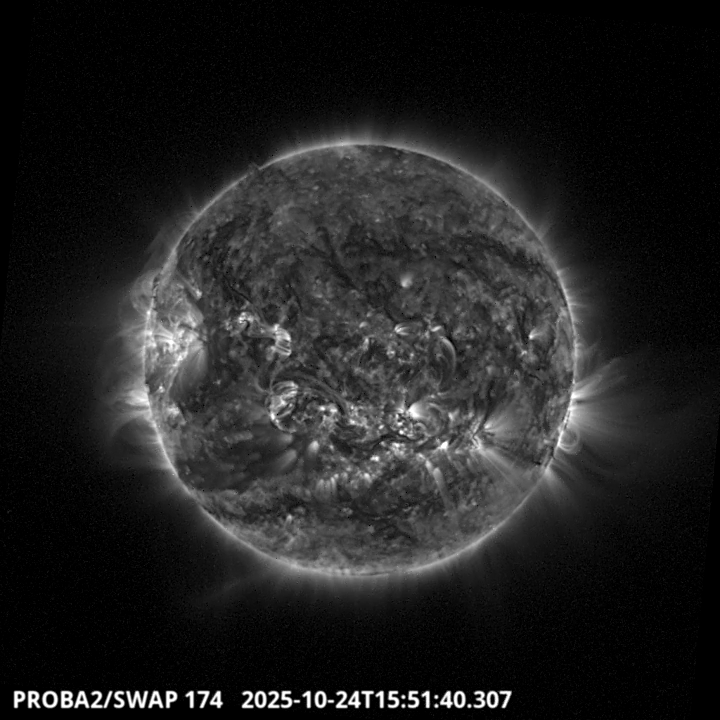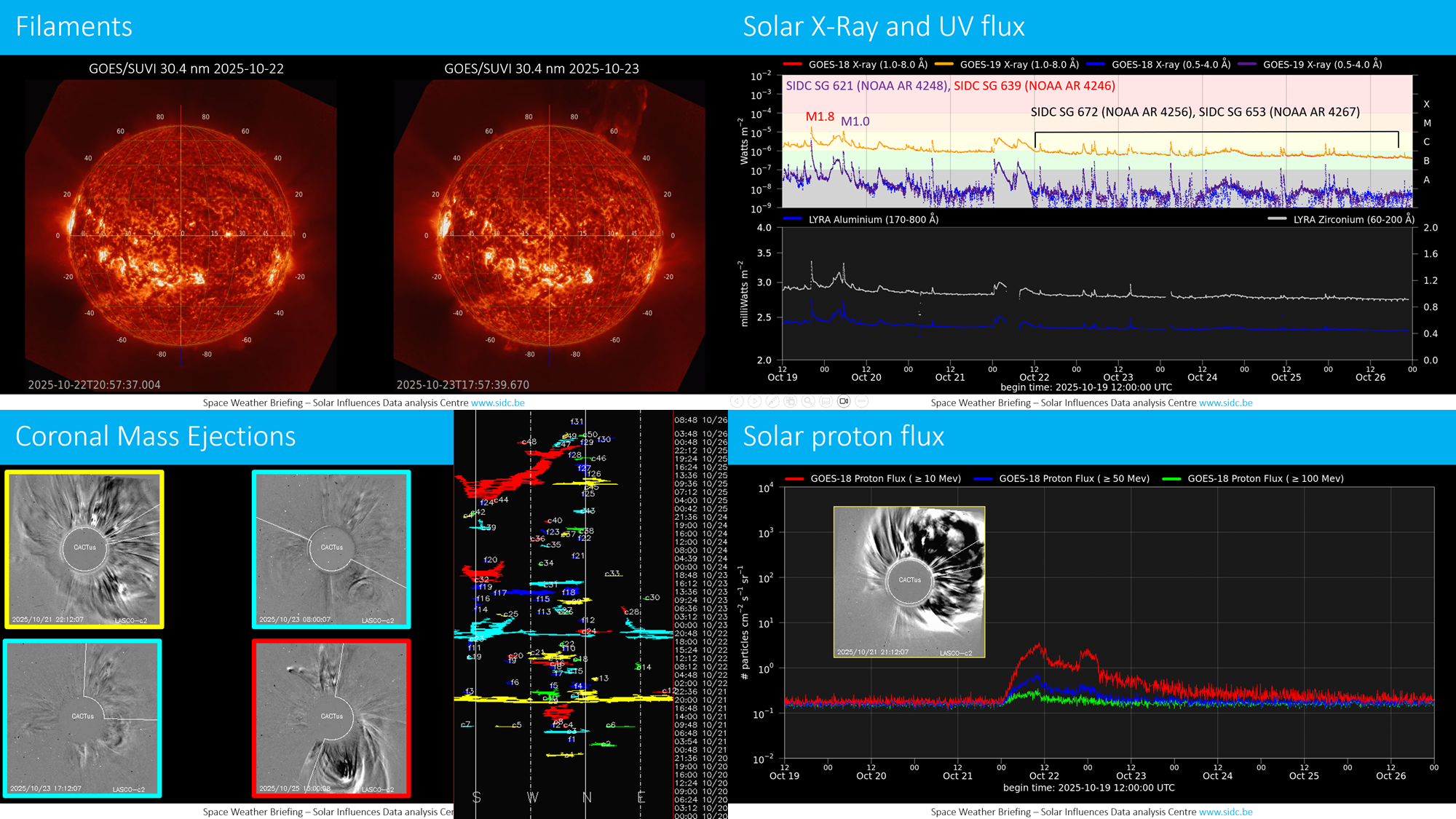- Table of Content
- 1.Word Search ES...
- 2.Review of Sola...
- 3.Noticeable Sol...
- 4.PROBA2 Observa...
- 5.International ...
- 6.Geomagnetic Ob...
- 7.The SIDC Space...
- 8.Review of Iono...
- 9.Upcoming Activ...
2. Review of Solar and Geomagnetic Activity
3. Noticeable Solar Events
4. PROBA2 Observations (20 Oct 2025 - 26 Oct 2025)
5. International Sunspot Number by SILSO
6. Geomagnetic Observations in Belgium
7. The SIDC Space Weather Briefing
8. Review of Ionospheric Activity
9. Upcoming Activities
Word Search ESWW
The European Space Weather Week (ESWW) is now in full swing at Umea, Sweden (https://esww.aeronomie.be/ ). There are no less than 16 Topical Discussion Meetings, 4 Plenaries, 5 Space Weather Research sessions, 9 Community-Driven sessions and 2 Application Pipeline sessions, as well as numerous side activities and meetings offered to hundreds of participants onsite and online.
Taking some key words from each of these sessions, a word search puzzle has been created. It has no hidden message in it. Hyphens have been ignored. Words can go in any direction and share letters as well as cross over each other. This puzzle was created with the Discovery Education online tool at https://puzzlemaker.discoveryeducation.com/ Good luck!

Review of Solar and Geomagnetic Activity
WEEK 1295 from 2025 Oct 20
Solar active regions (ARs) and flares
Solar flaring activity was moderate at the start of the week and low for the rest of the week. Over the course of the week, one M-class and thirty-two C-class flares were recorded. The largest flare was an M1.0 flare (SIDC Flare 5845), peaking at 05:27 UTC on October 20 and was associated with SIDC Sunspot Group 621 (NOAA AR 4248). This region was rotating behind the west limb at the beginning of the week but was responsible for most of the flaring activity during that period, together with SIDC Sunspot Group 674 (NOAA AR 4257; magnetic type beta) and with ARs behind the east limb. From October 22 onward, the majority of the flaring activity was produced by SIDC Sunspot Group 672 (NOAA AR 4256) and SIDC Sunspot Group 653 (NOAA AR 4267).
Coronal mass ejections
Several Coronal Mass Ejections (CMEs) were detected in the available coronagraph imagery over the past week. Of these, one was determined to be potentially Earth-directed, while the others were not expected to have any significant impact on Earth. A fast halo CME (SIDC CME 583) was observed in SOHO/LASCO-C2 coronagraph data starting at 20:24 UTC on October 21. The CME was directed primarily toward the northwest from Earth's perspective and was associated with type II and type IV radio emissions, detected at 20:07 UTC and 20:11 UTC, respectively. Analysis indicated that the source of the CME was located on the far side of the Sun and that it was not expected to arrive to Earth. Subsequent halo CMEs - SIDC CME 584 and 585 (observed at 20:36 UTC and 21:36 UTC on October 22) and SIDC CME 587 and 588 (observed at 07:48 UTC and 11:24 UTC on October 25) - were also associated with far-side eruptions and were not expected to impact Earth. A faint CME (SIDC CME 586) was observed in SOHO/LASCO-C2 imagery starting at 14:36 UTC on October 23. This CME was directed primarily toward the southwest from Earth's perspective and was possibly associated with a small eruption near SIDC Sunspot Group 672 (NOAA Active Region 4256). The CME was expected to mostly miss Earth, with a slight chance for a glancing blow around October 27.
Coronal holes
A small negative polarity coronal hole (SIDC Coronal Hole 133) crossed the central meridian late on October 21. A large recurrent positive polarity coronal hole (SIDC Coronal Hole 123) reached the central meridian on October 27.
Proton flux levels
The greater than 10 MeV proton flux, as measured by GOES-18, remained below the 10 pfu threshold throughout the week, though it was slightly elevated on October 22-23, likely due to the fast halo coronal mass ejection (SIDC CME 583) observed in SOHO/LASCO-C2 coronagraph data starting around 20:24 UTC on October 21.
Electron fluxes at GEO
The greater than 2 MeV electron flux measured by GOES 18 and GOES 19 remained below the 1000 pfu threshold throughout the week. The 24-hour electron fluence remained at normal levels.
Solar wind
Solar wind parameters were slightly disturbed at the start of the week under the influence of a high-speed stream (HSS), possibly originating from a recurrent negative polarity coronal hole (SIDC Coronal Hole 126). The solar wind speed reached values up to 610 km/s, and the interplanetary magnetic field values up to 10 nT. The magnetic field orientation was predominantly in the negative sector (field directed towards the Sun). After a brief return to slow solar wind conditions, solar wind parameters became slightly disturbed again from October 22. The interplanetary magnetic field reached values up to 10 nT, and the solar wind speed increased from around 380 km/s to 570 km/s, likely due to the arrival of a high-speed stream from a small equatorial negative polarity coronal hole (SIDC Coronal Hole 133). Solar wind conditions gradually transitioned to a slow solar wind regime toward the end of the week.
Geomagnetism
Geomagnetic conditions were mostly quiet to unsettled both globally and locally over Belgium throughout the week (NOAA Kp = 1-3; K-Bel = 1-3). Active conditions were briefly observed globally (NOAA Kp = 4) between 03:00 and 06:00 UTC on October 25 and locally over Belgium (K-Bel = 4) at around 18:00 UTC on October 24, due to mild HSS influence.
Noticeable Solar Events
| DAY | BEGIN | MAX | END | LOC | XRAY | OP | 10CM | TYPE | Cat | NOAA |
| 20 | 0510 | 0527 | 0538 | M1.0 | TM/1 | 4248 |
| LOC: approximate heliographic location | TYPE: radio burst type |
| XRAY: X-ray flare class | Cat: Catania sunspot group number |
| OP: optical flare class | NOAA: NOAA active region number |
| 10CM: peak 10 cm radio flux |
PROBA2 Observations (20 Oct 2025 - 26 Oct 2025)
Solar Activity
Solar flare activity fluctuated from low to moderate during the week.
In order to view the activity of this week in more detail, we suggest to go to the following website from which all the daily (normal and difference) movies can be accessed: https://proba2.oma.be/ssa
This page also lists the recorded flaring events.
A weekly overview movie can be found here (SWAP week 813). https://proba2.sidc.be/swap/data/mpg/movies/weekly_movies/weekly_movie_2025_10_20.mp4
Details about some of this week's events can be found further below.
If any of the linked movies are unavailable they can be found in the P2SC movie repository here https://proba2.sidc.be/swap/data/mpg/movies/
Friday Oct 24

Solar filament eruptions occurred in the Sun's southeast region, producing coronal mass
ejections (CMEs). The first one occurred around 12:20 UT and the second one occurred around
15:50 UT. Find a SWAP movie of the event here. https://proba2.sidc.be/swap/movies/20251024_swap_movie.mp4
International Sunspot Number by SILSO

The daily Estimated International Sunspot Number (EISN, red curve with shaded error) derived by a simplified method from real-time data from the worldwide SILSO network. It extends the official Sunspot Number from the full processing of the preceding month (green line), a few days more than one solar rotation. The horizontal blue line shows the current monthly average. The yellow dots give the number of stations that provided valid data. Valid data are used to calculate the EISN. The triangle gives the number of stations providing data. When a triangle and a yellow dot coincide, it means that all the data is used to calculate the EISN of that day.
Geomagnetic Observations in Belgium

Local K-type magnetic activity index for Belgium based on data from Dourbes (DOU) and Manhay (MAB). Comparing the data from both measurement stations allows to reliably remove outliers from the magnetic data. At the same time the operational service availability is improved: whenever data from one observatory is not available, the single-station index obtained from the other can be used as a fallback system.
Both the two-station index and the single station indices are available here: http://ionosphere.meteo.be/geomagnetism/K_BEL/
The SIDC Space Weather Briefing
The forecaster on duty compiled the SIDC SWx briefing that gives an overview of space weather activity from 20 to 26 October.
The pdf of the presentation can be found here: https://www.stce.be/briefings/20251027_SWbriefing.pdf

Review of Ionospheric Activity


VTEC time series at 3 locations in Europe from 20 Oct 2025 till 26 Oct 2025
The top figure shows the time evolution of the Vertical Total Electron Content (VTEC) (in red) during the last week at three locations:
a) in the northern part of Europe(N 61deg E 5deg)
b) above Brussels(N 50.5deg, E 4.5 deg)
c) in the southern part of Europe(N 36 deg, E 5deg)
This top figure also shows (in grey) the normal ionospheric behaviour expected based on the median VTEC from the 15 previous days.
The time series below shows the VTEC difference (in green) and relative difference (in blue) with respect to the median of the last 15 days in the North, Mid (above Brussels) and South of Europe. It thus illustrates the VTEC deviation from normal quiet behaviour.
The VTEC is expressed in TECu (with TECu=10^16 electrons per square meter) and is directly related to the signal propagation delay due to the ionosphere (in figure: delay on GPS L1 frequency).
The Sun's radiation ionizes the Earth's upper atmosphere, the ionosphere, located from about 60km to 1000km above the Earth's surface.The ionization process in the ionosphere produces ions and free electrons. These electrons perturb the propagation of the GNSS (Global Navigation Satellite System) signals by inducing a so-called ionospheric delay.
See http://stce.be/newsletter/GNSS_final.pdf for some more explanations; for more information, see https://gnss.be/SpaceWeather
Upcoming Activities
Courses, seminars, presentations and events with the Sun-Space-Earth system and Space Weather as the main theme. We provide occasions to get submerged in our world through educational, informative and instructive activities.
* Oct 27-31, European Space Weather Week, Umea, Sweden - https://esww.eu/
* Nov 17-19, STCE Space Weather Introductory Course, Brussels, Belgium - register: https://events.spacepole.be/event/217/ - Full
* Feb 9-11, 2026, STCE Space Weather Introductory Course, Brussels, Belgium - register: https://events.spacepole.be/event/255/
* Mar 16-18, 2026, STCE course: Role of the ionosphere and space weather in military communications, Brussels, Belgium - register: https://events.spacepole.be/event/258/
* Apr 20-21, 2026, STCE cursus: inleiding tot het ruimteweer, Brussels, Belgium - register: https://events.spacepole.be/event/260/
* Mar 23, 2026, STCE lecture: From physics to forecasting, Space Weather course, ESA Academy, Redu, Belgium
* Jun 15-17, 2026, STCE Space Weather Introductory Course, Brussels, Belgium - register: https://events.spacepole.be/event/256/
* Oct 12-14, 2026, STCE Space Weather Introductory Course, Brussels, Belgium - register: https://events.spacepole.be/event/257/
* Nov 23-25, 2026, STCE course: Role of the ionosphere and space weather in military communications, Brussels, Belgium - register: https://events.spacepole.be/event/259/
* Dec 7-9, 2026, STCE Space Weather Introductory Course for Aviation, Brussels, Belgium - register: https://events.spacepole.be/event/262/
To register for a course and check the seminar details, navigate to the STCE Space Weather Education Center: https://www.stce.be/SWEC
If you want your event in the STCE newsletter, contact us: stce_coordination at stce.be
